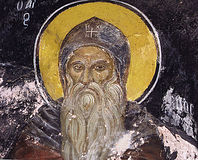

| Previous day | Next day |
| Old Style
July 18
|
Wednesday |
New Style
July 31
|
|
6th Week after Pentecost.
Tone 4.
Fast Day. |
Wine and oil allowed.
|
![]() Martyr Emilian of Silistra in Bulgaria (363).
Martyr Emilian of Silistra in Bulgaria (363). ![]() Martyr Hyacinth of Amastris (4th c.).
Martyr Hyacinth of Amastris (4th c.).
St. Pambo, hermit, of Egypt (4th c.). St. John the Much-suffering, of the Kiev Caves (1160). St. Pambo, recluse, of the Kiev Caves (13th c.). St. Leontius, founder of Karikhov Monastery (Novgorod) (1492).
New Hieromartyr Apollinarius (Mosalitinov), hieromonk of the St. Nicholas Monastery (Verkhoturye) (1918).
“Tolga” (1314) and “Kaluga” (1748) Icons of the Most Holy Theotokos.
Great-martyr Athanasius of Klysma, Egypt (4th c.). St. Barlaam, ascetic, of Bald Mountain, near Antioch in Syria (6th c.). St. Arnulf (Arnold) bishop of Metz (640). St. Frederich, bishop of Utrecht (Neth.) (9th c.). Sts. Stephen, patriarch of Constantinople (928), and John the Confessor, metropolitan of Chalcedon (9th c.). Hieromartyr Cosmas, hieromonk, of Gareji, Georgia (1630).
Repose of Abbess Mavrikia (1867) and Abbess Zosima (1933), both of Goritsy Convent.
Thoughts for Each Day of the Year
According to the Daily Church Readings from the Word of God
By St. Theophan the Recluse

Wednesday. [I Cor. 2:9-3:8; Matt. 13:31-36]
The kingdom is like a grain of mustard seed and leaven. A small grain of mustard seed grows up into a big bush; leaven penetrates the whole lump of dough and makes it leavened. Here, on the one hand, is an image for the Church, which in the beginning consisted only of the apostles and several other people, then spread and became most numerous, penetrating all of humanity; on the other hand, it is an image of the spiritual life revealed in every person. Its first seed is the intention and determination to be saved through pleasing God, upon faith in the Lord and Saviour. This determination, no matter how firm, is like a tiny dot. In the beginning it embraces only one’s consciousness and activities; then from this all of the activity of a spiritual life develops. Its movement and strength multiply and mature within its own self, and it begins to penetrate all the powers of the soul—the mind, will, feelings, then fills them with itself, makes them leavened according to its spirit, and penetrates the entire constitution of the human nature, body, soul, and spirit in which it was engendered.
Thursday. [I Cor. 3:18-23; Matt. 13:36-43]
And shall cast them (those who offend and do iniquity) into a furnace of fire: there shall be wailing and gnashing of teeth. Then shall the righteous shine forth as the sun in the Kingdom of their Father. Thus will be carried out the division of good and evil, light and darkness. Now is the period of time in which they are mixed. It pleased the Lord to arrange that the freedom of creatures should grow and be strengthened in good through the struggle with evil; evil is tolerated within the vicinity of inward freedom, and in contact with a person externally. It does not determine anything, only tempts. One who feels a temptation must not fall, but enter into battle. He who conquers is freed from one temptation, and advances forward and upward to find new temptation there—and so on, until the end of his life. Oh, when will we comprehend this meaning of the evil which tempts us, so we might arrange our lives according to this understanding! The strugglers are finally crowned, and pass on to the other life where there is neither sickness nor sorrows from the outside, and where they become inwardly pure like angels of God, free from the sting of tempting inclinations and thoughts. This is how the triumph of light and good is being prepared, and it will be revealed in all of its glory on the last day of the world.
Articles
 Martyr Emilian of Silistria in BulgariaThe Holy Martyr Emilian, who was a Slav, suffered for Christ during the reign of Emperor Julian the Apostate (361-363) |
 Martyr Hyacinthus of AmastrideaThe Holy Martyr Hyacinthus was born into a pious Christian family in the city of Amastridea (now Amastra in Anatolia). |
 Venerable Pambo the Hermit of EgyptSaint Pambo lived the ascetic life in the Nitrian desert in Egypt. |






